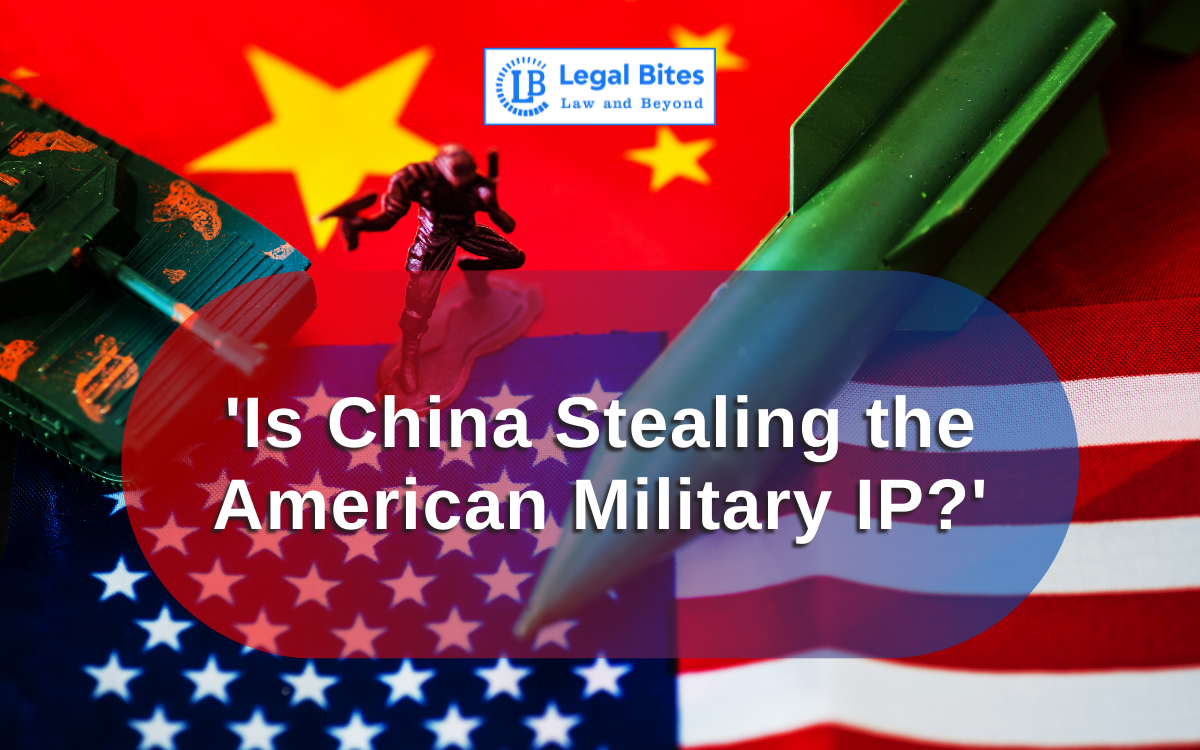
Last Updated on by Admin LB
The Article ‘Is China Stealing the American Military IP?’ by Sanath Vijairaghavan will give an insight into China’s habit of attempting to steal promising US technological innovations and also the act of the People’s Liberation Army in copying US military multi-domain tactful warfare concepts. The effort is to create awareness about this malafide act so that certain productive steps can be taken to reduce that kind of work in China. The emphasis is laid on insufficient cybersecurity measures and the author urges the US to increase its cybersecurity measures and also widen the laws governing IP in Contracts.
Introduction to the American Military IP threatened by China
At a time when the world faces a new arms race between the United States and its two mightiest adversaries; the importance of protecting US Military assets and Intellectual Property from espionage activities is seeing rising importance among the military, political and bureaucratic circles in America. National Security and America’s long-standing technological and military edge stands threatened by the activities of China.
As the importance of Intellectual Property in the defence sector sees rising importance, we shall examine the nature of the Chinese legal system with respect to intellectual property, instances of intellectual property theft by the Chinese Government and shall discuss possible solutions which could minimise such coercive activities.
China: a regime that facilitates IP Theft
The basic structure of the Chinese Political establishment is one that facilitates IP Theft. China lacks an independent judicial and legal system, and its IP protection mechanisms are intrinsically linked to its legal system. Since the judicial and legal system in the country is essentially dictated and governed by the Chinese Communist Party, the knowledge of such theft and espionage would be in the knowledge of top officials in Beijing and would likely have their blessings as well.
A congressional committee hearing noted the following points regarding China and their anti-piracy efforts along with IP regulations:
“A precondition to China entering the World Trade Organization was that it implement intellectual property protections. They have been given time to address this concern, and have failed.”
Existing provisions for safeguarding of American IP in Federal Contracts
The laws governing IP differ for federal contracts as compared to contracts for commercial and civilian purposes. When the Department of Defence enters into a contract with an enterprise, there are various restraints placed on the negotiating capacity of the enterprise. The Bayh-Dole Act deals with the governing of defence contracts. Regarding the disposition of rights, the act states
“when it is determined by a Government authority which is authorized by statute or executive order to conduct foreign intelligence or counter-intelligence activities that the restriction or elimination of the right to retain title to any subject invention is necessary to protect the security of such activities”.
Such restrictions do act as a bulwark against the certain transfers of technology to adversaries but fall short on espionage activities. The United States had IP protection enshrined in the constitution giving it an early advantage, yet China’s activities pose a threat to American Defence with the further development of AI and espionage strategies.
Instances of China stealing American Military technology
China employs a variety of strategies to acquire American military technology and designs, including buying, stealing and reverse engineering American designs and technology. In order to create indigenous capabilities, the Chinese Government has purchased, stolen, reverse engineered, and codeveloped/coproduced through coerced technological transfers, and usage of cyber espionage.
One example of this includes the US F16 fighter jets, which when sold to Pakistan in the 1980s, are believed to have fallen into the hands of the Chinese by means of visiting technicians, who may have dissembled and examined the sophisticated jet without American approval or knowledge at the time. China may also have acquired crucial technologies of the F16 jet via a defence agreement with Israel, an agreement to which America was not a party.
China is also accused of paying American citizens to provide missile technology and stealing naval ship designs, hacking into NASA to gather information on the space shuttle among others. Infiltration of the databases of major oil companies which led to the subsequent theft of their trade secrets has also been attributed to Chinese hackers.
The employees of a semiconductor manufacturing firm have been accused of stealing trade secrets in 2012. Hackers in China have also been accused of stealing blueprints for the PAC-3, THAAD, Aegis, F/A-18 fighter jet, V-22 Osprey and Black Hawk Helicopters, according to a Defence Science Board assessment in 2013. In 2014, Chinese nationals penetrated Boeing’s database and were able to access confidential information about the C-17 cargo jet and the F22 and F35 fighter jets.
One of the recent examples includes the development of China’s stealth J20 and J31 fifth Generation fighter, which are believed to have stolen design and technological capabilities from Lockheed Martin’s F22 and F35 jets respectively. The Chinese J31 is a virtual copy of the American F35 in design and tries to emulate the capabilities of the American Jet.
Preventive measures
The US must push the private sector to implement stronger cybersecurity regulations that provide many levels of security. It will contribute to a cyber-security paradigm that recognises the significance of a defence-in-depth strategy, which as well debunks the myth that there is a sole solution that can counteract the Chinese from stealing the Pentagon’s most valuable intellectual property.
Authorise the Department of Defence to protect private networks
While considering this proposal, it’s beneficial to consider 3 elements of a conventional cyber security strategy:-
- A perimeter or gateway defence is the first. Its tools are installed atop the network’s perimeter and assist in identifying and preventing identified adversaries and malware from infiltrating and conceding a network.
- Secondly, it entails software to continuously observe network traffic in order to detect and thwart unusual behaviours via attackers who might have eluded discovery by the perimeter defence.
- Thirdly, the creation of a comprehensive training programme to assist operators in recognising certain general intruder strategies that lead to a user granting an intruder trusted network capabilities, allowing the intruder unrestricted access to sensitive data within the system.
Hack Backs
Allowing the private sector to erase the data which been stolen can be a strategy that should be given consideration. Hack back refers to a company’s capacity to respond to information theft by halting the theft and erasing the data from the breacher’s network. The Computer Fraud and Abuse Act (CFAA) currently prohibits companies from hacking backs.
Greater emphasis on prosecution of those involved
People involved in state-sponsored cyber espionage have been indicted by the US Department of Justice. Individuals in these circumstances might be difficult to indict and prosecute. Despite this, there are a few ways to attribute an attack that doesn’t need the government to reveal the method is used to find the breach.
Data Obfuscation
Data obfuscation techniques like data masking and zero-trust architecture can prevent hackers from obtaining or comprehending the contents of critical files
Conclusion
In an everchanging world, with competition and conflict between mighty nuclear powers, intellectual property and its protection finds a key role in an arms race between America and its adversaries. Authoritarian regimes with shady backgrounds in IP rights like China poses a challenge to firms whose data has been stolen, as well as a national security risk to the United States. It’s imperative for the United States to follow measures on improving cyber security, laws governing IP in contracts and holding those guilty accountable.
